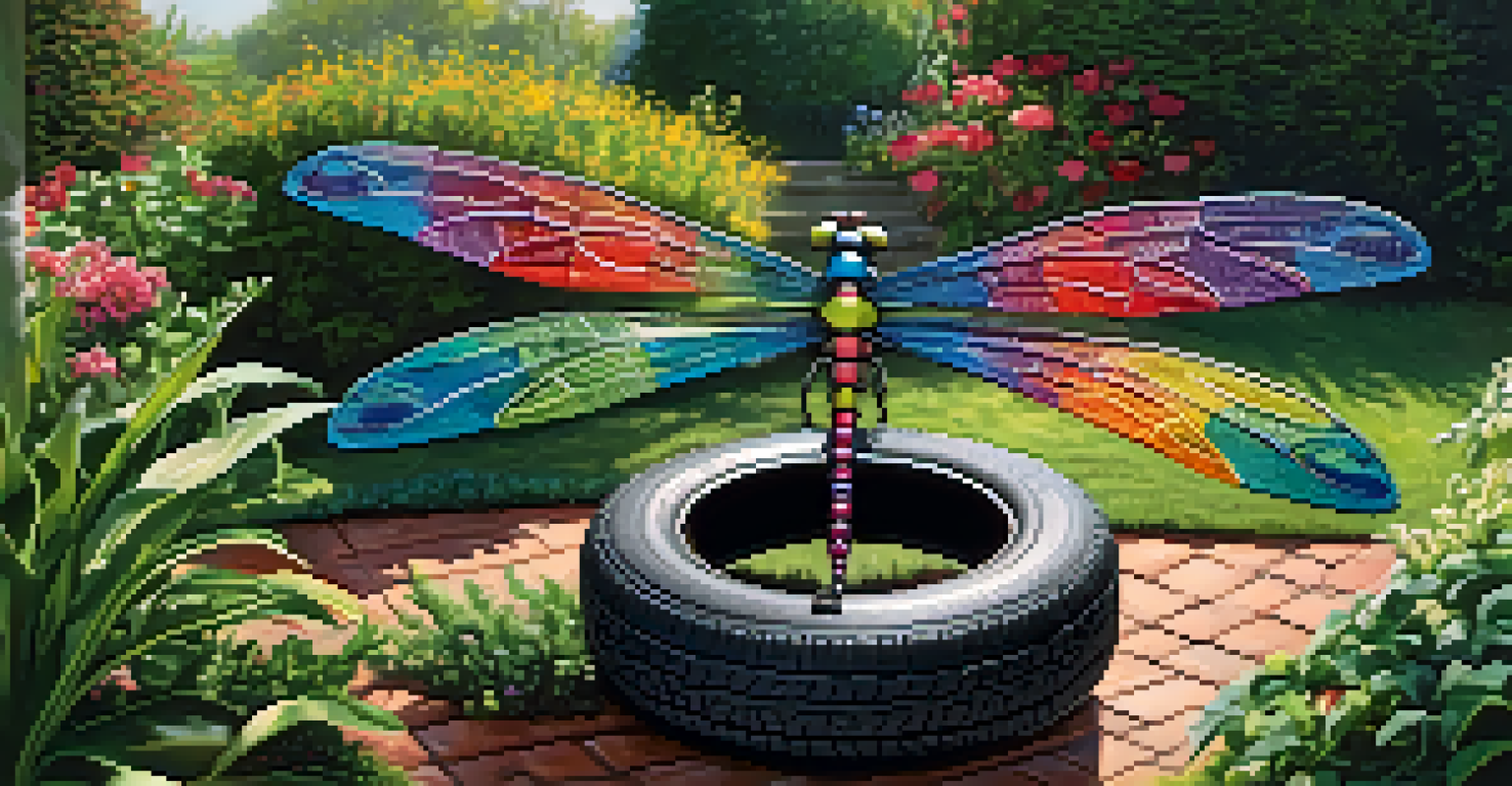The Art of Carving Recycled Tire Sculptures

Understanding the Beauty of Recycled Tire Art
Recycled tire sculptures transform discarded rubber into stunning works of art. These creations not only showcase artistic talent but also promote sustainability by repurposing materials that would otherwise contribute to environmental waste. Each sculpture tells a unique story, reflecting the artist's vision while highlighting the importance of recycling.
Art is not what you see, but what you make others see.
Tire art serves as a powerful reminder of what we can achieve when we think outside the box. The vibrant colors and textures found in tires add an unexpected twist to traditional sculpture. This blend of creativity and environmental consciousness makes tire art not just visually appealing, but also meaningful.
Artists often use tires to create everything from whimsical animal figures to abstract shapes. The versatility of the medium allows for endless possibilities, making each piece a true reflection of the artist’s imagination. As we delve deeper into the world of tire sculptures, we’ll uncover the techniques and inspirations that drive this unique form of artistry.
Essential Tools for Carving Tire Sculptures
Before diving into tire sculpting, it’s crucial to gather the right tools. Essential items include a utility knife, a heat gun, and various carving tools to shape and detail the rubber. Each tool plays a specific role in the carving process, helping artists achieve clean cuts and intricate designs.

A utility knife is your best friend for initial cuts, while a heat gun can soften the rubber, making it easier to mold and shape. Carving tools such as chisels or rotary tools help add finesse and detail to your sculpture, transforming a simple shape into a work of art. Having the right tools at your disposal can make a significant difference in the quality of your finished piece.
Transform Waste into Art
Recycled tire sculptures turn discarded rubber into stunning art pieces, promoting sustainability and creativity.
As you embark on your carving journey, remember that practice is key. Familiarize yourself with your tools and experiment with different techniques to find your unique style. The more comfortable you become with your tools, the more intricate and impressive your sculptures will be.
Choosing the Right Tires for Your Sculpture
Not all tires are created equal when it comes to sculpting. When selecting tires for your project, consider factors such as size, tread pattern, and rubber thickness. Larger tires can provide a sturdy base for bigger sculptures, while smaller tires may be ideal for intricate details.
The greatest threat to our planet is the belief that someone else will save it.
Additionally, the tread pattern can influence the artistic direction of your piece. Some artists prefer tires with unique designs, as these can add texture and visual interest. By choosing the right tires, you can enhance the overall aesthetic of your sculpture and create a more impactful piece.
Don’t shy away from experimentation! Mixing and matching different types of tires can lead to unexpected and exciting results. Embrace the imperfections in the materials you choose, as they can add character and depth to your artwork.
The Creative Process: From Concept to Creation
Every great sculpture begins with a spark of inspiration. Start by brainstorming ideas and sketching out your concepts. Think about the story you want to tell or the emotions you want to evoke with your sculpture. This initial planning phase is essential to guide your creative process.
Once you have a solid concept, begin gathering your materials and tools. Lay out your sketches alongside the tires you plan to use. This will help you visualize how the different elements will come together and allow you to adjust your design as needed.
Essential Tools for Sculpting
Gathering the right tools, such as utility knives and heat guns, is crucial for achieving intricate tire sculptures.
As you start carving, don’t be afraid to adapt your original idea. Sometimes the material can inspire new directions, leading to unexpected and beautiful outcomes. The journey from concept to creation is where much of the magic happens, so embrace the process and let your creativity flow.
Techniques for Carving and Shaping Tires
Carving tires requires both patience and technique. Start with broad cuts to shape the overall form, then gradually work your way to finer details. Using a combination of cutting and heating methods can help you achieve the desired shape and texture.
For finer details, consider using chisels or rotary tools to carve intricate designs. These tools can help you create patterns, textures, and features that bring your sculpture to life. Remember to take your time and enjoy the process, as rushing can lead to mistakes.
Don’t forget about safety! Always wear protective gear, such as gloves and goggles, when working with sharp tools and materials. Prioritizing safety will allow you to focus on your art without unnecessary distractions.
Finishing Touches: Painting and Sealing Your Sculpture
Once your sculpture is carved to perfection, it’s time to add the finishing touches. Painting your sculpture can enhance its visual appeal and allow you to express your artistic vision. Consider using outdoor-safe paint to ensure your artwork lasts if displayed outside.
Sealing your sculpture is equally important. A clear sealant can protect your piece from the elements and prevent wear over time. This step is crucial, especially if you plan to display your sculpture in a garden or public space.
Showcase Your Artwork Creatively
Displaying your completed tire sculpture in well-chosen settings can enhance its visual appeal and engage viewers.
Take your time with the finishing touches, as they can elevate your sculpture from good to truly stunning. Each layer of paint and sealant adds depth and character, bringing your recycled tire art to life in vibrant ways.
Displaying Your Tire Sculpture: Tips and Ideas
Now that your sculpture is complete, how do you showcase your masterpiece? Consider the setting where you’ll display your art. Outdoor spaces, such as gardens, parks, or yards, can be perfect for larger sculptures, while indoor spaces can accommodate smaller pieces.
Lighting can also play a significant role in how your sculpture is perceived. Strategic lighting can highlight the textures and colors of your artwork, creating a captivating visual experience. Think about using spotlights or natural light to enhance your sculpture’s features.

Don’t hesitate to share your work with others! Participating in local art fairs or workshops can help you gain exposure and connect with fellow artists. Sharing your journey not only inspires others but also fosters a community around this unique art form.